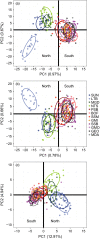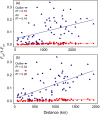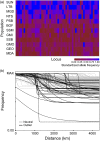Identifying patterns of dispersal, connectivity and selection in the sea scallop, Placopecten magellanicus, using RADseq-derived SNPs
- PMID: 28035239
- PMCID: PMC5192885
- DOI: 10.1111/eva.12432
Identifying patterns of dispersal, connectivity and selection in the sea scallop, Placopecten magellanicus, using RADseq-derived SNPs
Abstract
Understanding patterns of dispersal and connectivity among marine populations can directly inform fisheries conservation and management. Advances in high-throughput sequencing offer new opportunities for estimating marine connectivity. We used restriction-site-associated DNA sequencing to examine dispersal and realized connectivity in the sea scallop Placopecten magellanicus, an economically important marine bivalve. Based on 245 individuals sampled rangewide at 12 locations from Newfoundland to the Mid-Atlantic Bight, we identified and genotyped 7163 single nucleotide polymorphisms; 112 (1.6%) were identified as outliers potentially under directional selection. Bayesian clustering revealed a discontinuity between northern and southern samples, and latitudinal clines in allele frequencies were observed in 42.9% of the outlier loci and in 24.6% of neutral loci. Dispersal estimates derived using these clines and estimates of linkage disequilibrium imply limited dispersal; 373.1 ± 407.0 km (mean ± SD) for outlier loci and 641.0 ± 544.6 km (mean ± SD) for neutral loci. Our analysis suggests restricted dispersal compared to the species range (>2000 km) and that dispersal and effective connectivity differ. These observations support the hypothesis that limited effective dispersal structures scallop populations along eastern North America. These findings can help refine the appropriate scale of management and conservation in this commercially valuable species.
Keywords: RADseq; connectivity; dispersal; outlier loci; population genomics; population structure; sea scallop; single nucleotide polymorphism.
Figures








Similar articles
-
Oceanographic variation influences spatial genomic structure in the sea scallop, Placopecten magellanicus.Ecol Evol. 2018 Feb 11;8(5):2824-2841. doi: 10.1002/ece3.3846. eCollection 2018 Mar. Ecol Evol. 2018. PMID: 29531698 Free PMC article.
-
Genetic differentiation and signatures of local adaptation revealed by RADseq for a highly dispersive mud crab Scylla olivacea (Herbst, 1796) in the Sulu Sea.Ecol Evol. 2021 May 4;11(12):7951-7969. doi: 10.1002/ece3.7625. eCollection 2021 Jun. Ecol Evol. 2021. PMID: 34188864 Free PMC article.
-
Fine-scale temperature-associated genetic structure between inshore and offshore populations of sea scallop (Placopecten magellanicus).Heredity (Edinb). 2019 Jan;122(1):69-80. doi: 10.1038/s41437-018-0087-9. Epub 2018 May 17. Heredity (Edinb). 2019. PMID: 29773897 Free PMC article.
-
The use of genetic clines to estimate dispersal distances of marine larvae.Ecology. 2006 May;87(5):1094-103. doi: 10.1890/0012-9658(2006)87[1094:tuogct]2.0.co;2. Ecology. 2006. PMID: 16761586 Review.
-
Using neutral, selected, and hitchhiker loci to assess connectivity of marine populations in the genomic era.Evol Appl. 2015 Sep;8(8):769-86. doi: 10.1111/eva.12288. Epub 2015 Jul 28. Evol Appl. 2015. PMID: 26366195 Free PMC article. Review.
Cited by
-
Global, regional, and cryptic population structure in a high gene-flow transatlantic fish.PLoS One. 2023 Mar 20;18(3):e0283351. doi: 10.1371/journal.pone.0283351. eCollection 2023. PLoS One. 2023. PMID: 36940210 Free PMC article.
-
Linkage Disequilibrium Estimation in Low Coverage High-Throughput Sequencing Data.Genetics. 2018 Jun;209(2):389-400. doi: 10.1534/genetics.118.300831. Epub 2018 Mar 27. Genetics. 2018. PMID: 29588288 Free PMC article.
-
Outside your shell: exploring genetic variation in two congeneric marine snails across a latitude and temperature gradient.BMC Genomics. 2025 May 15;26(1):486. doi: 10.1186/s12864-025-11603-z. BMC Genomics. 2025. PMID: 40375137 Free PMC article.
-
Seascape genomics reveals population isolation in the reef-building honeycomb worm, Sabellaria alveolata (L.).BMC Evol Biol. 2020 Aug 10;20(1):100. doi: 10.1186/s12862-020-01658-9. BMC Evol Biol. 2020. PMID: 32778052 Free PMC article.
-
Selecting RAD-Seq Data Analysis Parameters for Population Genetics: The More the Better?Front Genet. 2019 May 29;10:533. doi: 10.3389/fgene.2019.00533. eCollection 2019. Front Genet. 2019. PMID: 31191624 Free PMC article.
References
-
- Allendorf, F. W. , Hohenlohe, P. A. , & Luikart, G. (2010). Genomics and the future of conservation genetics. Nature Reviews Genetics, 11(10), 697–709. - PubMed
-
- Arnold, B. , Corbett‐Detig, R. B. , Hartl, D. , & Bomblies, K. (2013). RADseq underestimates diversity and introduces genealogical biases due to nonrandom haplotype sampling. Molecular Ecology, 22(11), 3179–3190. - PubMed
-
- Barber, B. J. , Getchell, R. , Shumway, S. , & Schick, D. (1988). Reduced fecundity in a deep‐water population of the giant scallop Placopecten magellanicus in the Gulf of Maine, USA. Marine Ecology Progress Series, 42(3), 207–212.
-
- Barton, N. H. , & Bengtsson, B. O. (1986). The barrier to genetic exchange between hybridising populations. Heredity, 57(3), 357–376. - PubMed
LinkOut - more resources
Full Text Sources
Other Literature Sources

